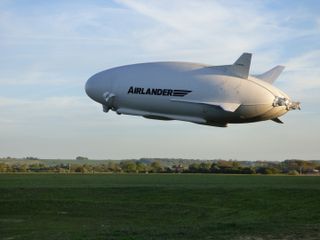World's Largest Aircraft Completes Successful Test Flight

It's a plane, it's a blimp … it's the world's largest aircraft.
A massive airship dubbed the Airlander 10 recently completed a successful test flight, bringing the helium-filled behemoth one step closer to commercial use.
Though it looks like a massive blimp, the Airlander 10 combines technology from airplanes, helicopters and airships. It is designed to stay aloft at altitudes of up to 20,000 feet (6,100 meters) for up to five days when manned, according to Hybrid Air Vehicles, the company that built the aircraft. And at a mammoth 302 feet (92 m) long, it is the largest aircraft currently flying. [In Photos: Building the World’s Largest Airship (Airlander 10)]
On May 10, the Airlander 10 flew for a total of 180 minutes to test the aircraft's handling, improved landing technology and more, according to Hybrid Air Vehicles. This was only the third flight of the Airlander 10. It first debuted as HAV-304, and successfully flew in 2012 as part of the U.S. Army’s Long Endurance Multi-intelligence Vehicle program. The reimagined and modified Airlander 10 made its maiden voyage in August 2016, kicking off a flight test program to assess the aircraft's performance and attempting to fly the airship farther away from its base in Cardington, England.
This latest flight had two main objectives, beyond safely completing a takeoff, flight and landing. The first was to determine how the Airlander handles, including the aircraft's new, additional "landing feet" that make up the Auxiliary Landing System (ALS). The second was to collect data on the flight's performance, such as airspeed, according to Hybrid Air Vehicles.
During the successful test flight, the Airlander 10 "handled superbly," said Dave Burns, the Airlander 10's chief test pilot. A statement from Hybrid Air Vehicles said the flight test team was "very pleased" with its initial analysis of the Airlander 10.
Hybrid Air Vehicles said the Airlander 10 could one day be used for search and rescue missions, by border control agents, for crowd monitoring, security, filming or academic research.
Sign up for the Live Science daily newsletter now
Get the world’s most fascinating discoveries delivered straight to your inbox.
"There will also be passenger variants for the ultimate flying experience and eventually Hybrid Air Vehicles will fulfil a crucial role in point-to-point cargo transportation to remote areas," company officials said in a statement.
Original article on Live Science.


Cybertruck-looking 'mobile aircraft carrier' developed in China can hide away and launch a 2-person flying car

9 weird, wonderful and terrifying robots we've seen at CES 2025 so far — from an android companion to a robotic mixologist

Scientists discover new kind of cartilage that looks like fat-filled 'Bubble Wrap'
